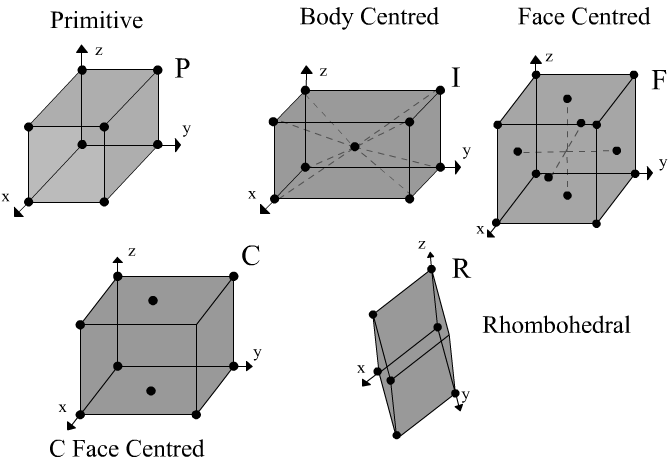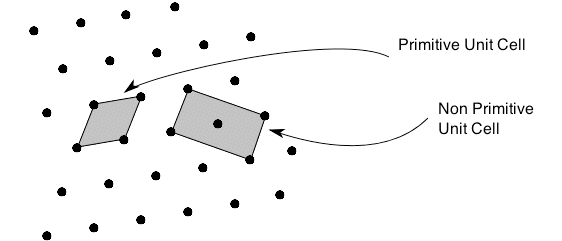What Is a Unit Cell?
The structure of a crystal can be seen to be composed of a repeated element in three dimensions. This repeated element is known as the unit cell. It is the building block of the crystal structure. Therefore, a unit cell can be described in terms of the lattice (set of identical points). In other words, a unit cell is the smallest three-dimensional portion of a complete space lattice which when repeated over and again in different directions produces the complete space lattice.
In three dimensions, the unit cell is any parallelepiped whose vertices are lattice points whereas in two dimensions, the unit cell is any parallelogram whose vertices are lattice points. There are two types of unit cell: Primitive and non–primitive cell. Primitive unit cells contain only one lattice point, which is made up from the lattice points at each of the corners. Non-primitive unit cells contain additional lattice points, either on a face of the unit cell or within the unit cell and so have more than one lattice point per unit cell.
The most common types of unit cell are the primitive(P) unit cell with one lattice point per unit cell; the face centred(F) unit cell with additional lattice points at the centre of each face and four lattice points per unit cell; and the body centred(I) unit cell with a lattice point in the middle of the unit cell and two lattice points per unit cell. Other cell types are the C face centred unit cell and the rhombohedral unit cell.

What You Need To Know About Unit Cell
- Unit cell is the smallest group of atoms that has the overall symmetry of a crystal and from which the entire lattice can be built up by repetition in three dimensions.
- In three dimensions, the unit cell is any parallelepiped whose vertices are lattice points.
- In two dimensions, the unit cell is any parallelogram whose vertices are lattice points.
- Unit cell has parallelepiped geometry.
- Unit cell is a three dimensional structure.
What Is a Primitive Cell?
A primitive cell is the smallest possible unit cell of a lattice, having lattice points only at each of its eight vertices. In other words, a primitive cell is a minimum volume cell corresponding to a single lattice point of a structure with translational symmetry in 2 dimensions, 3 dimensions or other dimensions.
For each crystal structure there is a conventional unit cell, usually chosen to make the resulting lattice as symmetric as possible. However, the conventional unit cell is not always the smallest possible choice. A primitive unit cell of a particular crystal structure is the smallest possible unit one can construct such that, when tiled, it completely fills space.

What You Need To Know About Primitive Cell
- A primitive cell is the smallest possible unit cell of a lattice, having lattice points only at each of its eight vertices.
- Primitive unit cells contain only one lattice point, which is made up from the lattice points at each of the corners.
- 2D primitive has parallelogram geometry whereas 3D primitive cell has parallelepiped geometry.
- Primitive cell can be a two or three dimensional structure.
- It is often the case that a primitive unit cell will not reflect the symmetry of the crystal structure.
Difference Between Unit Cell And Primitive Cell In Tabular Form
| BASIS OF COMPARISON | UNIT CELL | PRIMITIVE CELL |
| Description | Unit cell is the smallest group of atoms that has the overall symmetry of a crystal and from which the entire lattice can be built up by repetition in three dimensions. | A primitive cell is the smallest possible unit cell of a lattice, having lattice points only at each of its eight vertices. |
| Lattice Points | The unit cell is a repeating part of the crystal structure and therefore has several lattice points. | Primitive unit cells contain only one lattice point, which is made up from the lattice points at each of the corners. |
| Dimension | Unit cell is a three dimensional structure. | Primitive cell can be a two or three dimensional structure. |
| Geometry | Unit cell has parallelepiped geometry. | 2D primitive has parallelogram geometry whereas 3D primitive cell has parallelepiped geometry. |
Conclusion
A crystal lattice refers to the periodic structure of a crystal. The unit cell is a repeating part of the crystal structure. You can think of the crystal lattice as being made of multiple unit cells stacked together. A unit cell is one way to describe the structure of the crystal.
The lattice refers to the set of all lattice points which typically is infinite, but the unit cell is confined to a particular volume with a discrete number of points.